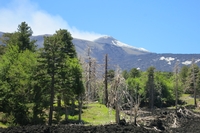 trip last year opened my eyes to portions of Sicily that I hadn’t visited previously, while also indicating how comprehensively excellent top producers have become in crafting nuanced, individuated wines from distinct locations and grape varieties. To be sure, I’ve been tasting the rise of Sicilian wine for years on end, but doing so intermittently while also tasting constantly from elsewhere, so I confess that the full magnitude of Sicily’s advancement has snuck up on me. However, my second visit was a week-long, on-site bath in beauty that finally triggered an epiphany for me during 2019, and I fully intend to make up for lost time this year.
trip last year opened my eyes to portions of Sicily that I hadn’t visited previously, while also indicating how comprehensively excellent top producers have become in crafting nuanced, individuated wines from distinct locations and grape varieties. To be sure, I’ve been tasting the rise of Sicilian wine for years on end, but doing so intermittently while also tasting constantly from elsewhere, so I confess that the full magnitude of Sicily’s advancement has snuck up on me. However, my second visit was a week-long, on-site bath in beauty that finally triggered an epiphany for me during 2019, and I fully intend to make up for lost time this year.
Having gotten my own confession out of the way, I’ve got some questions for you: Is it your impression of Sicily that it is a hot location making big, chunky wines? Do you presume that the reds are better than the whites? Or that neither the whites nor reds are as noteworthy as Marsala, Sicily’s traditional, fortified specialty? Or that all the best producers are carpetbagger operations spun off by wine companies from Italy’s more prosperous north? Would you guess that recent advancements are concentrated on the slopes of Mt. Etna, which is the one spot that has managed to gain some fame on the world wine scene? Do you figure that Sicily is all about volcanic soils, given Etna’s prominence? Or that it is climatically constant on the hot side of the spectrum, with no appreciable vintage variation, given that the island’s southernmost portion sits to the south of the northern edge of Africa?
Every one of these propositions is wrong. If you’ve held back from buying Sicilian wine on account of any of these assumptions, I hope you’ll open your mind – and then your wallet – to provide Sicily’s vintners a chance to trigger an epiphany for you as well.
I’m not convinced that a picture is worth a thousand words, but I do know that a few sips of superb wine are more convincing than a torrent of vinous verbiage. So, I’ll turn to specific recommendations in a moment, but only after setting a few things straight:
Sicily is highly varied in growing conditions, with a truly vast array of microclimates and soil types scattered across a very sizeable land mass. Almost all generalizations about Sicilian viticulture are doomed to failure as a 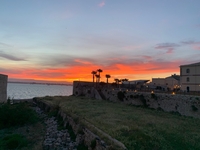 result, and it is a simple matter to demonstrate that the island can produce everything from lithe, elegant whites and reds to big, punchy wines that actually do fit the now-stale stereotypes from decades past. The best producers do include some companies based on the north of the “boot,” but for every one of those, there are many more who bootstrapped up to excellence from Sicily itself. Some international varieties show well on Sicilian soil, as do some migrants from elsewhere in Italy like Fiano, but Sicily’s indigenous grape varieties are the real stars on the current scene.
result, and it is a simple matter to demonstrate that the island can produce everything from lithe, elegant whites and reds to big, punchy wines that actually do fit the now-stale stereotypes from decades past. The best producers do include some companies based on the north of the “boot,” but for every one of those, there are many more who bootstrapped up to excellence from Sicily itself. Some international varieties show well on Sicilian soil, as do some migrants from elsewhere in Italy like Fiano, but Sicily’s indigenous grape varieties are the real stars on the current scene.
In sum, Sicily is a complex and captivating wine world unto itself, arguably deserving intensive study and tasting experimentation every bit as much as all 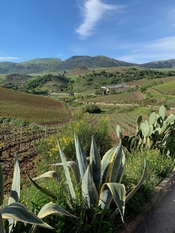 the Italian regions combined to the north of Florence or the south of Rome.
the Italian regions combined to the north of Florence or the south of Rome.
I’m not kidding, and that’s not hyperbole. No matter how much you think you know about wine, Sicily has a host of surprises to blow your mind, and if you have a taste for travel too, it deserves a place high on your list of destinations.
If I could, I’d take a walk with you to a single spot on Etna from which you could see vines in vivid bloom…plus a vast snow pack…plus a fresh lava flow…all without even turning your head.
Or, if we were out in north-western Sicily, inland from Palermo, we could take a drive through some of the most beautifully rolling countryside you’ve ever seen, with vineyards interspersed with other plantings to create a gorgeous patchwork effect that’s further accentuated by rocky outcroppings but almost no humans to be seen. Until, that is, we’d turn into one of the wonderfully unruly country towns, with people of all ages laughing out on the street, but keeping one eye out for kids riding horses…bareback, with exactly no regard for anything but their own amusement.
Sadly, we’re unlikely to be able to enjoy either of these experiences together, but I can at least point you toward some specific bottles to pique your interest in learning more about wild, wonderful Sicily and its many terrific wines. And as 2020 progresses, I’ll write a lot more with that objective in mind:
Whites:
Alessandro di Camporeale (Sicilia DOC) Vigna di Mandranova Catarratto “Benedè” 2015 ($23): This remarkable wine shows amazing complexity along the lines of the finest renditions of Assyrtiko from Santorini 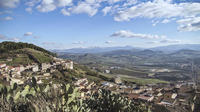 and an ability to show positive development in bottle over time akin to important reds. Along with stone fruit notes, it displays lovely suggestions of toasted almonds and saffron, with prominent salty minerality in the finish. Medium-bodied, this seems to take on weight as the wine warms with air in the glass, but even with that taken into account, it punches above its weight in terms of depth and flavor impact in relation to sheer size. Sourced from foothill vineyards overlooking the Mandranova plains, this is fantastic wine. 94
and an ability to show positive development in bottle over time akin to important reds. Along with stone fruit notes, it displays lovely suggestions of toasted almonds and saffron, with prominent salty minerality in the finish. Medium-bodied, this seems to take on weight as the wine warms with air in the glass, but even with that taken into account, it punches above its weight in terms of depth and flavor impact in relation to sheer size. Sourced from foothill vineyards overlooking the Mandranova plains, this is fantastic wine. 94
Benanti (Etna Superiore) Carricante “Pietramarina” 2015 ($100): This seems like an insanely expensive wine…until you taste it. Seems like it might be past its prime too…until you taste it. Presented stone cold to me at a professional tasting in Siracusa, it was alluring even before having a chance to warm and loosen up, with beautiful balance between fruit and minerality. It becomes ever more generous with time in the glass, showing sexy fruit recalling peaches and tangerines before the minerality gains traction and takes over the wine’s long, long finish. Very complex and extremely classy, this is just hitting its stride four years after the fruit was picked. 94
Pietradolce (Etna DOC) Carricante “Archineri” 2018 ($40): A wine that speaks much more of rock than of sun, this is so intensely mineral that you can 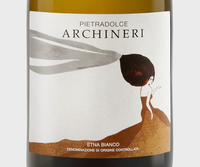 smell the saline edge coming before it even hits your palate, along with an ultra-delicate topnote of fresh white flowers. Light and acidic and ultra-refreshing, with lean, lemony fruit, it shows just enough sweet primary fruit to avoid coming off as austere, with a very prolonged finish marked predominantly by salty mineral notes. Gorgeous, but subtly so. 94
smell the saline edge coming before it even hits your palate, along with an ultra-delicate topnote of fresh white flowers. Light and acidic and ultra-refreshing, with lean, lemony fruit, it shows just enough sweet primary fruit to avoid coming off as austere, with a very prolonged finish marked predominantly by salty mineral notes. Gorgeous, but subtly so. 94
Terra Costantino (Etna DOC) “Contrada Blandano” 2015 ($35): A blend of 75% Carricante and 25% Catarratto, this shows some development from time in bottle in terms of color, aroma and flavor, but all of it is positive…hence my term “development” rather than “aging.” Aromatically, a hint of tertiary bottle bouquet works beautifully with primary fruit notes recalling melon and sweet tangerine, and all of these notes re-appear on the palate, with some lees accents for good measure. Rich and expressive, this is an attention-grabber. 94
Tornatore (Etna DOC) “Pietrarizzo” 2017 ($35): This superb producer is now represented in the USA by Gallo’s import division, though I’ve yet to see this particular wine on our side of the pond. Let’s hope that changes soon, as this 2017 blend of 95% Carricante and 5% Catarratto is generous and easy to enjoy, but also sharply detailed and very serious and complex. Lean enough that I’d classify it as “light-bodied” on a restaurant list (but only after wondering if it should be designated as medium-bodied), it very expressive and flavorful while never losing its impression of freshness. The fruit profile is balanced between suggestions of citrus and melon, reinforcing the ambiguity of light vs. medium body, but there’s also a subtle hint of stone fruit in the finish along with a faint nuttiness that makes this a wine worthy of extended contemplation. Or, you could just knock it back…with great pleasure. Terrific wine that nobody could fail to love. 94
Planeta (Sicilia DOC) Carricante “Eruzione 1614” 2017 ($38): This wine is way less expensive in Europe than in the USA, but don’t let that spoil the  fun, as it is still worth every penny and more for $40. There’s 10% Riesling blended in with the Carricante, and ingeniously so, as the lightly floral topnotes enhance aromatic complexity and work wonderfully with the fruit scents and flavors recalling green apples, citrus fruit and mandarin oranges. The balance of fruit and acidity is either perfect…or so close to perfect that I couldn’t fault it in either direction. Well represented in the USA even if not so well priced, you should be able to find it, and should definitely give it a try. 93
fun, as it is still worth every penny and more for $40. There’s 10% Riesling blended in with the Carricante, and ingeniously so, as the lightly floral topnotes enhance aromatic complexity and work wonderfully with the fruit scents and flavors recalling green apples, citrus fruit and mandarin oranges. The balance of fruit and acidity is either perfect…or so close to perfect that I couldn’t fault it in either direction. Well represented in the USA even if not so well priced, you should be able to find it, and should definitely give it a try. 93
Tornatore (Etna DOC) Carricante 2018 ($18): An unusually fleshy, forward, fruity expression of this wonderful grape variety, this is a truly medium-bodied Carricante that bursts with mandarin orange and tangerine fruit that pushes the mineral notes into the background—but without snuffing them out. Unusual, but undeniably delicious in its way. 93
Alessandro di Camporeale (Sicilia DOC) Vigna di Mandranova Grillo 2018 ($20): Due to the very wet conditions of the growing season during 2018 (at least in the western sections of Sicily), this wine is unusually lean and zesty in this vintage, so don’t assume that other vintages will show the same character. In most years, it would be bigger, juicier and more tropical in fruit profile, and more akin to the big renditions of Grillo that are more widely available in the USA from Sicily’s various coastal regions. By contrast, this 2018 is openly fruity but downright prickly with acidity, as it was vinified reductively in stainless steel with 6 months of lees contact. It shows some citrus rind bitterness in the finish, but that’s beautifully offset by the fresh fruit notes, and the overall effect is both complex and harmonious. This is an example of a very skilled viticultural and winemaking team making lemonade from a lemon, which is also to say that this is a world class winery deserving of a much higher profile than it enjoys currently in the USA. 92
Centopassi (Terre Siciliane IGT) Catarratto “Terre Rosse di Giabbascio R14” 2014 ($18): This is an impressive white given its age, even when acknowledging that 2014 was a good vintage in western Sicily. The “Terre Rosse” name derives from the reddish sandy soils in which the vines were planted. Interesting interplay is provided by contrasting fruit notes of citrus and melons, and though there’s a faint “petrol” streak showing time in bottle, primary fruit is also in evidence, lending additional interplay and complexity. Impressive, interesting, and high in value. 91
Centopassi (Sicilia Superiore DOC) Grillo – Catarratto “Giato” 2018 ($15): Get this: The winery is part of an association of nine properties 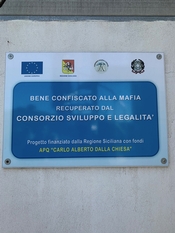 scattered across Sicily and the south of the “boot” that are owned by the state…after being seized from the Mafia. They cultivate about 1,400 hectates based on clay and sand, so this was a sizeable seizure from whence olive oil and pasta are also produced. Everything looks new, and I expect the solid wines to become even better with time. This blend of 60% Grillo and 40% Catarratto is a little shy aromatically, but quite bright with excellent acidity and some interesting mineral tones in the finish. More refreshing than complex, this is likely reflective of the wet 2018 vintage in western Sicily, so perhaps not representative of most vintages, but still well done…and very good for the money. 90
scattered across Sicily and the south of the “boot” that are owned by the state…after being seized from the Mafia. They cultivate about 1,400 hectates based on clay and sand, so this was a sizeable seizure from whence olive oil and pasta are also produced. Everything looks new, and I expect the solid wines to become even better with time. This blend of 60% Grillo and 40% Catarratto is a little shy aromatically, but quite bright with excellent acidity and some interesting mineral tones in the finish. More refreshing than complex, this is likely reflective of the wet 2018 vintage in western Sicily, so perhaps not representative of most vintages, but still well done…and very good for the money. 90
Reds:
Terra Costantino (Etna DOC) “DeAetna” 2017 ($28): Delicious and reasonably priced, this is a great introduction to the wonders that can be worked by blending in a little Nerello Cappuccio (10%) along with the lion’s share of Nerello Mascalese…and then not over-working the wine in the cellar. It is light in pigment concentration, but that appearances are deceiving in this case, as the textural softness of the wine permits all of its fruit show on the palate. Yet, what shows on the palate is hardly all fruit, as there’s a lot of salty minerality that rides atop the juicy red cherry flavors like a rodeo monkey on a trick pony. Very broadly appealing, this is sweet and soft enough to seduce Sicily novices, but complex enough to captivate the geekiest sommelier. This producer also makes a very good “Contrada Blandano” that’s more expensive and released notably later…up to 3 years. But don’t torment yourself searching for that, as the DeAetna is much more abundant and every bit as good in its way. 94
Alessandro di Camporeale (Sicilia DOC) Vigna di Mandranova Nero d’Avola “Donnatà” 2017 ($20): This superb rendition of Nero d’Avola is sourced from a climate in the Mandranova area that is cooler than vineyards closer to Catania or most other sites in Sicily, and the variety looks quite different as a result, with absolutely no over-ripe or “chunky” character…even from a conspicuously hot growing season in 2017. It is fully ripe, yet shows excellent freshness, with notes of both red and black berries and a suggestion of clack cherries as well. A very restrained hint of wood lends additional complexity while keeping the gorgeous fruit in the forefront. The balance and proportionality of fruit, acidity, tannin and wood is impeccable, and the overall profile of the wine is almost perfectly harmonious. For the record, I tasted this from magnum, though I doubt that would have made much difference by comparison to a 750 ml bottle less than two years after the vintage. I had not even finished writing my raw tasting note at the winery before looking for a source that could sell this (and the 2016 “Kaid” Syrah) to me in the USA…to no avail, though I hope a strong importer will take note of this exceptional producer. 93
Alessandro di Camporeale (Sicilia DOC) Vigna di Mandranova Syrah “Kaid” 2016 ($26): The world is full of good Syrah, but hardly full of examples this good at prices this reasonable. Brought up in new 500-liter casks for one year, it shows a bit of woodspice and a little toasty topnote, but no overtly woody character. Medium-bodied but very close to full (which is just right for Syrah, to my taste), it shows very deep flavors and impressive concentration for its weight, and marvelous purity also…despite the new oak involved in vinification. Annual production is roughly 40,000 bottles, but that availability number will be reduced significantly within one minute of when I finally find this at retail. 93
Donnafugata (Etna DOC) “Sul Vulcano” 2016 ($36): This is made entirely 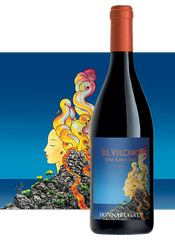 from Nerallo Mascalese, but that isn’t featured on the interesting label, and finished product does indeed seem influenced more by the volcano than the variety. So impressively delicate that the descriptor “exquisite” seems unavoidable, this is so subtle that it seems uncanny in its impression of weightlessness, yet it is quite expressive in aroma and even more so in flavor, with red cherry notes supported by ultra-fine tannins. 93
from Nerallo Mascalese, but that isn’t featured on the interesting label, and finished product does indeed seem influenced more by the volcano than the variety. So impressively delicate that the descriptor “exquisite” seems unavoidable, this is so subtle that it seems uncanny in its impression of weightlessness, yet it is quite expressive in aroma and even more so in flavor, with red cherry notes supported by ultra-fine tannins. 93
Gulfi (Etna) “Reseca” 2014 ($42): Wines from this producer are quite individuated, so don’t even bother trying to get a grip on a “house style.” This one is crafted entirely from Nerello Mascalese, but the finished wine is at least as “savory” as it is “fruity,” so it comes off as an expression of the vineyard and the cellar much more than the grape variety. The fruit is quite ripe and 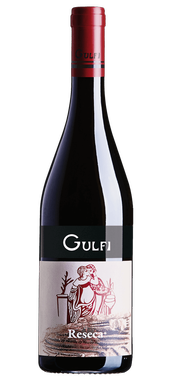 evident, but riding alongside it are punchy suggestions of newly tanned leather and a faint hint of volatile acidity (which is definitely below the “flaw” threshold). Teetering between modern fruitiness and a more traditional profile, this is great fun to drink. Lots of fine tannins will enable it to work well with food, but if you open it up before dinner, it is unlikely to last long enough to make it to the table. 93
evident, but riding alongside it are punchy suggestions of newly tanned leather and a faint hint of volatile acidity (which is definitely below the “flaw” threshold). Teetering between modern fruitiness and a more traditional profile, this is great fun to drink. Lots of fine tannins will enable it to work well with food, but if you open it up before dinner, it is unlikely to last long enough to make it to the table. 93
Palmento Costanzo (Etna DOC) “Mofete Rosso” 2016 ($35): A blend of 80% Nerello Mascalese and 20% Nerello Cappuccio, this is was very skillfully grown and made. It is deliciously ripe and sweet but definitely not over the line into “candied” territory, as salty minerality provides a counterpoint to the wine’s juiciness. Although it is elegantly light in overall profile, it still shows real depth of flavor, as the softness of the tannins allows the fruit to show itself fully and linger through the finish. Not the most complex wine you’ll find from Etna, but as straightforwardly enjoyable wine as you’re likely to find from anywhere. This producer also makes a “Nero di Sei” bottling with the same blend, and the 2015 is excellent, but it will likely to be harder to find, as only 20% as much is made as this “Mofete Rosso.” 93
Pietradolce (Etna DOC) “Vigna Barbagalli” 2015 ($90): Pietradolce is a terrific producer, and if you’re scared off by the price of this wine, don’t hesitate to opt instead for the entry level Etna Rosso, which rings up for $25 and is excellent in the 2017 vintage (92). Still, this shows the estate’s upper end capabilities fully, with gorgeously sweet fruit that is entirely captivating but neither simple nor simply dominant, as a host of subtle nuances also present themselves aromatically and on the palate. A wonderful example of Nerello Mascalese. 93
Tasca d’Almerita (Etna DOC) “Contrada Sciaranuova” 2016 ($40): Tasted side-by-side, I liked this much more than the same producer’s “Contrada Pianodario,” also from the 2016 vintage and likewise made entirely from Nerello Mascalese grown on Etna. This is juicier and sweeter and much less woody, though I couldn’t quite tell whether that was because wood wasn’t utilized in the cellar or whether superior fruit had simply soaked up the oak. In any case, this features gorgeous fruit recalling ripe pie cherries above all, and though that fruit analogy could make the wine seem un-serious, the framing from plenty of fine tannin makes this very promising as a dinner companion. 93
Tornatore (Etna DOC) “Pietrarizzo” 2017 ($50): I tasted this immediately after Pietradolce’s excellent 2017 Etna Rosso (92 points, $25), and though I’d certainly have preferred two bottles of that to one of these for $50, I worry that tasting order worked to its disadvantage. This is significantly lighter but still alluringly sweet, with admirably pure fruit, no overt wood, ultra-fine tannins, and excellent proportionality. The finish is delicate but very persistent, with every flavor note tailing off symmetrically. Impressive Nerello Mascalese on a small scale for a warm vintage. 93
Connect on Twitter: @Michael_Franz
